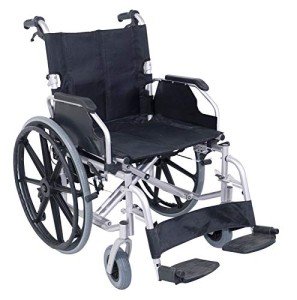Five Lessons You Can Learn From Bariatric Wheelchair 24 Inch Seat

Bariatric Wheelchair Seat Width
Seat Width
Having the right seat width is necessary to wheelchair users who spend longer periods in their chairs. Too narrow a seat will trigger pressure on the hips and thighs which might lead to sores or pressure points. Having too large a seat can also make it hard for the user to reach the hand rims to move themselves or maneuver in little spaces.
To measure the appropriate seat width an individual would sit on a chair usually and have their measurement taken throughout their lap at the largest point which is normally their hips. A wheelchair measuring tape can be utilized to determine this, however a backyard stick is preferred as it prevents individuals from wrapping the tape around their hips which would provide an unreliable outcome.
The basic wheelchair seat width is 16" (narrow grownup), 18" (basic adult), and 20" (broad adult). For bariatric patients, a 24" seat is offered. This durable extra large bariatric wheelchair from Medline features swing-away footrests, a carbon steel frame with rust- and chip-resistant chrome plating, and easy-to-clean vinyl upholstery. It has a weight capacity of 500 pounds.
Seat Depth
Typically, the seat depth of a bariatric wheelchair was added 2" to the measurement taken at the user's best point (normally their hips). This was indicated to accommodate extra layers of clothes that may be used during winter. However, this practice is becoming less common as wheelchair users have the ability to invest more time inside your home and are not wearing long coats. This makes the seat depth of a chair less important when choosing a bariatric wheelchair. Nevertheless, it is still crucial to select an alternative that offers appropriate support for larger users.
The Medline folding additional large bariatric manual wheelchair features a comfortable 24" seat width and a durable slide tube silver vein frame. It likewise has an adjustable axle and tool-free elevating legrests.
Seat Height
When it concerns figuring out the proper wheelchair seat width you need to constantly determine from the user's best point which is typically their hips. You will also require to consider whether the user is going to be using a winter season coat as this may add 2" to the width required.

When a wheelchair is in use it must only be operated on level surfaces with the wheel locks fully engaged. This is to avoid the chair from having the ability to move inclines that are 10 degrees or greater. It is likewise crucial to bear in mind that any activity that might move the center of mass in the chair should be finished with care. This includes grabbing products that need the person to lean out of their seat or attempting to stand up from it.
Whenever you have the chair in use it is recommended that you routinely inspect it for damage and lube any locations that are deemed essential. For example, the casters need to be lubed by getting rid of the caster fork and using a multi-purpose grease to use to the caster stem bearings. Similarly, the foot plates can be adjusted by loosening up the bolt and after that moving them to the preferred position. This permits the feet to sit easily on the footplate and avoids any pressure points from forming. This can be really unpleasant for the user and if left unattended, can result in pressure sores.
Weight Capacity
Bariatric wheelchairs are developed to support more weight than basic wheelchairs. This makes them stronger and much better equipped to deal with falls. They are likewise typically larger and larger, making them less maneuverable in tight areas than standard wheelchairs. They need cars with special ramps and lifts to pack them, in addition to motorists who know how to finest transport them from one place to the next.
When selecting My Mobility Scooters , consider its weight capacity as it will be the primary determining aspect in whether it will accommodate your passenger's needs. The weight capacity of the chair is typically listed as a fixed load, implying that it indicates the amount of weight the chair can comfortably hold while standing still. Nevertheless, some makers also note an active load that is based on a drop test and can simulate the result of somebody taking a seat in the chair. This may be a more reliable measurement of the weight limit, depending on your needs.
If you plan to carry out activities that move your center of gravity in the seat (such as reaching for things), make certain to have front casters pointed in a forward direction and wheel locks engaged so the chair will not topple. Likewise, inspect that casters are oiled frequently to avoid extreme wear and abrasions. The lubrication procedure involves removing the fork, separating the caster from the wheel, and greasing the caster stem bearings with high-quality multi-purpose grease.
